Colorado’s skies are adorned with a rich tapestry of owls, sixteen distinct species that grace the state’s diverse landscapes.
From the iconic Great Horned Owl to the diminutive Northern Pygmy Owl, these fascinating birds contribute to the ecological harmony of Colorado’s ecosystems.
This exploration into the realm of 16 Owls in Colorado unveils their unique sizes, habitats, and roles within the intricate web of nature.
Each species possesses its own allure, from the haunting calls of the Boreal Owl to the daytime prowess of the Northern Pygmy Owl.
Join us on a journey through the varied terrains of Colorado as we delve into the lives of these mesmerizing creatures, understanding their significance and the conservation efforts required to safeguard their presence in the Centennial State. Stay sharp.
16 Owls in Colorado
Explore the diverse owl species that call Colorado home. From the majestic Great Horned Owl to the elusive Northern Pygmy Owl, these fascinating birds inhabit various ecosystems across the state.
Delve into their unique characteristics, lifestyles, and conservation status as we unveil the enchanting world of Colorado’s owls.
1. Great Horned Owl
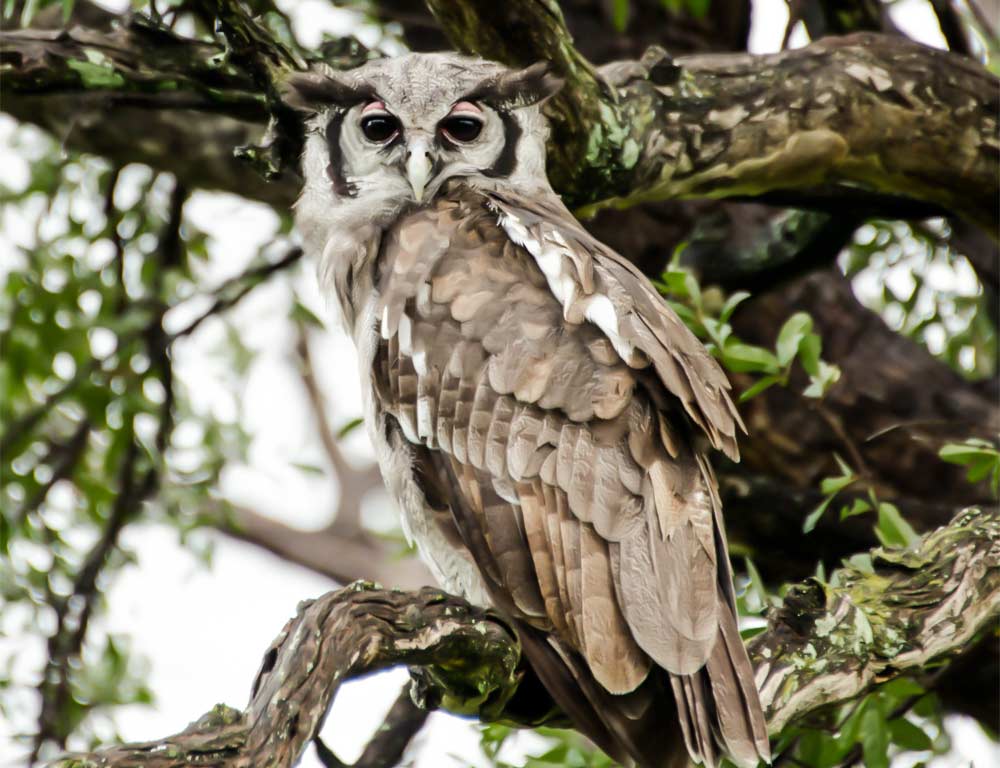
- Scientific Name: Bubo virginianus
- Size: 18-25 inches
- Weight: 2-5.5 pounds
- Food: Varied diet including mammals, birds, and reptiles
- Wingspan: 3.3-4.8 feet
- Population: Common and widespread
- Life Span: 5-15 years
- Status: Least Concern
The Great Horned Owl is a formidable and adaptable predator in diverse Colorado habitats. Renowned for its large size and distinctive ear tufts, it is a skilled nocturnal hunter.
It exhibits remarkable hunting prowess and versatility when feeding on a wide range of prey, from rodents to other birds.
Its powerful talons and keen eyesight make it a top predator in the Colorado ecosystem. The Great Horned Owl is known for its hooting calls during the breeding season, establishing territories in woodlands, plains, and urban areas.
Nesting in tree cavities or even repurposed nests of other large birds raises one brood per year. Their resilience, adaptability, and ability to thrive in varied environments contribute to their status as a common and widespread species in Colorado.
2. Barn Owl
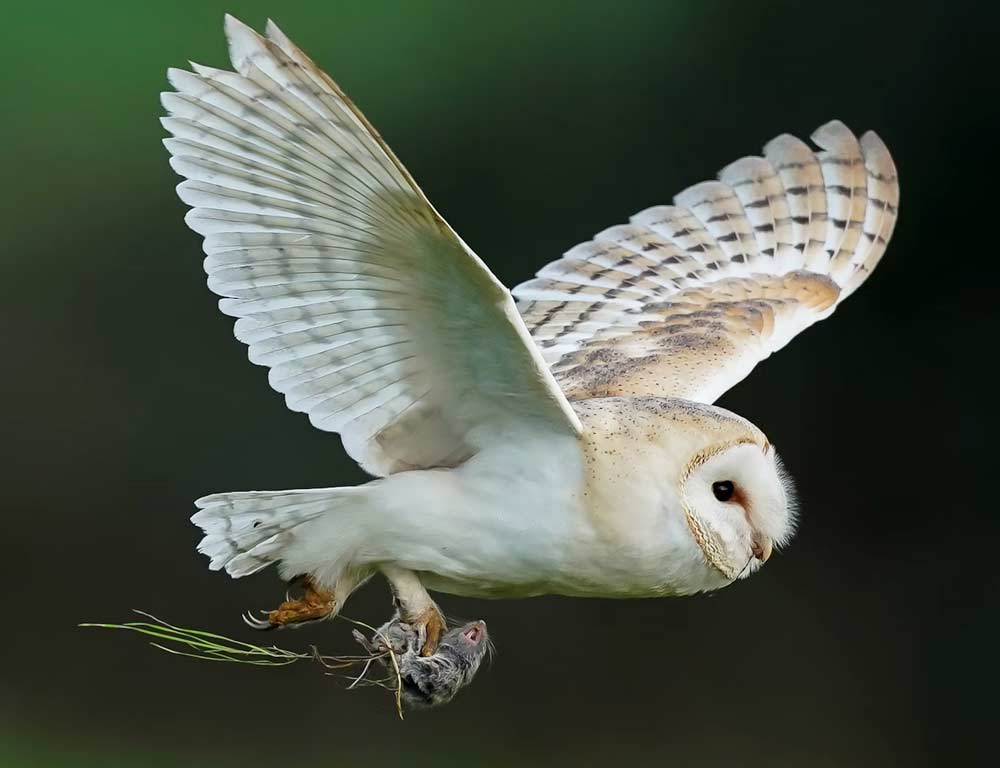
- Scientific Name: Tyto alba
- Size: 12-15 inches
- Weight: 14-24 ounces
- Food: Mainly small mammals like rodents
- Wingspan: 38-47 inches
- Population: Stable but declining
- Life Span: 2-4 years (wild)
- Status: Near Threatened
With its heart-shaped face, the Barn Owl is a charismatic and nocturnal bird of prey in Colorado. Preferring open habitats like farmlands and grasslands, it is an effective hunter, relying on its exceptional hearing to locate prey.
Feeding predominantly on small mammals, especially rodents, it plays a crucial role in pest control. Barn Owls typically nest in barns, silos, and other man-made structures.
The species faces challenges due to habitat loss, pesticide use, and vehicle collisions. Conservation efforts are essential to maintain their populations, and initiatives like providing nest boxes can contribute to their survival.
3. Snowy Owl
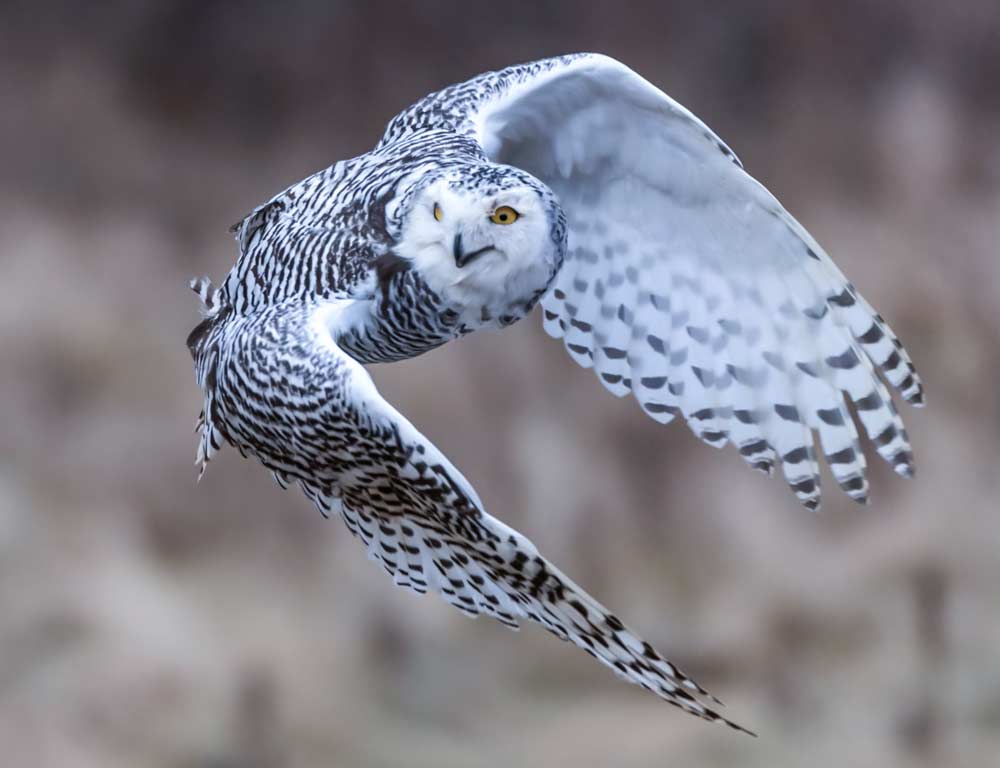
- Scientific Name: Bubo scandiacus
- Size: 20-28 inches
- Weight: 3.5-6.6 pounds
- Food: Primarily lemmings and other small mammals, occasionally birds
- Wingspan: 49-59 inches
- Population: Varies, with irruptions causing fluctuations
- Life Span: 9.5 years (average)
- Status: Least Concern
With its striking white plumage, the Snowy Owl is a rare but charismatic winter visitor to Colorado.
Adapted to Arctic tundra, these owls migrate south in irregular irruptions, driven by fluctuations in their prey populations. While predominantly a bird of the far north, they can be spotted in open landscapes during winter.
Their diet primarily consists of lemmings, showcasing their dependence on the cyclic availability of prey. Snowy Owls are known for their diurnal hunting behavior, taking advantage of the long days in their Arctic breeding grounds.
During irruption years, bird enthusiasts may glimpse these majestic owls in Colorado, adding a touch of Arctic wilderness to the state’s diverse avian population.
4. Eastern Screech Owl
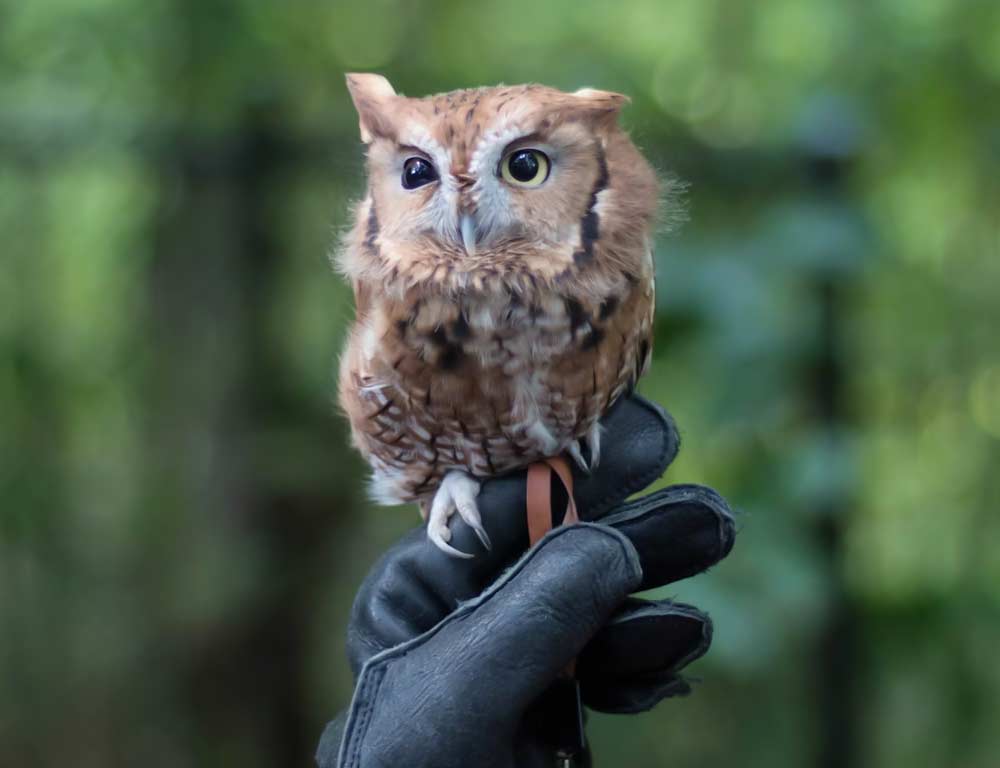
- Scientific Name: Megascops asio
- Size: 6-10 inches
- Weight: 4-9 ounces
- Food: Mainly insects, small mammals, and birds
- Wingspan: 18-24 inches
- Population: Stable
- Life Span: 1-14 years (wild)
- Status: Least Concern
The Eastern Screech Owl, a small and adaptable species, is found in various habitats throughout Colorado. With excellent camouflage, it comes in two color morphs – red and gray.
Preferring wooded areas, it nests in tree cavities and man-made nest boxes. It’s primarily a nocturnal hunter, feeding on insects, small mammals, and birds.
Despite its small size, the Eastern Screech Owl is a proficient predator, contributing to pest control in its ecosystem. Its haunting trill is a characteristic sound of the night in many parts of Colorado, where it has adapted well to urban and suburban environments.
5. Western Screech Owl
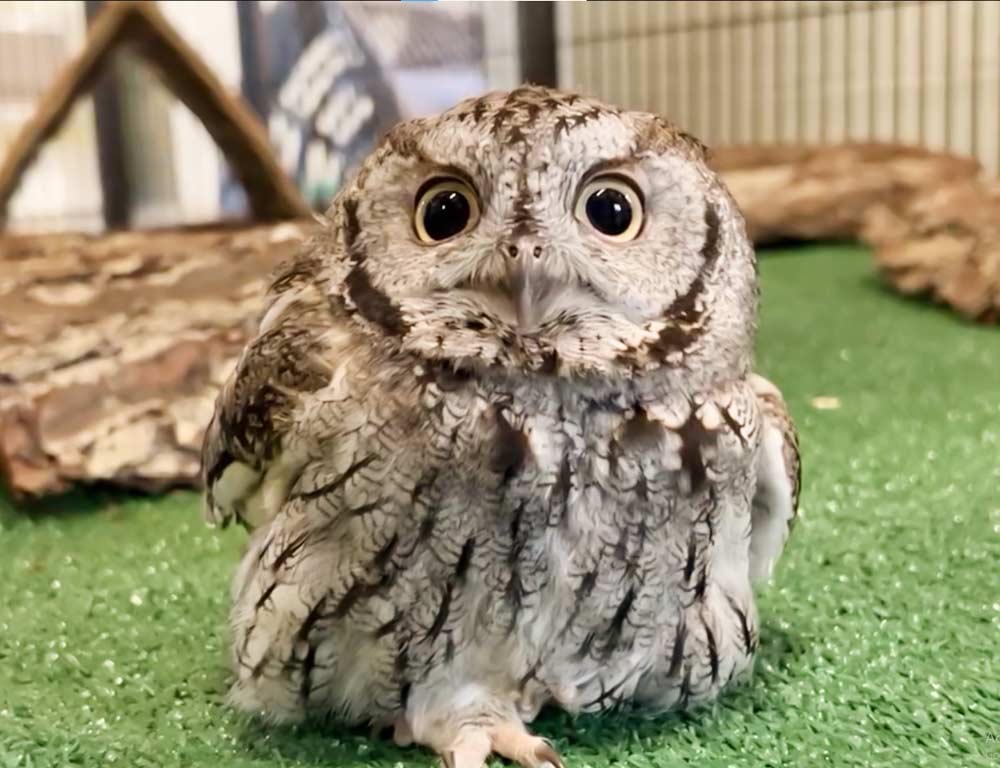
- Scientific Name: Megascops kennicottii
- Size: 7-10 inches
- Weight: 3-9 ounces
- Food: Insects, small mammals, birds
- Wingspan: 18-24 inches
- Population: Stable
- Life Span: 1-14 years (wild)
- Status: Least Concern
The Western Screech Owl, closely related to the Eastern Screech Owl, inhabits various environments in Colorado, from forests to deserts.
Similar in size and habits, it’s a nocturnal hunter and relies on its keen senses to locate prey. Like its eastern counterpart, it nests in tree cavities and readily adopts man-made nest boxes.
Its presence in diverse landscapes makes it a valuable member of the local ecosystem, contributing to controlling insect and rodent populations.
6. Burrowing Owl
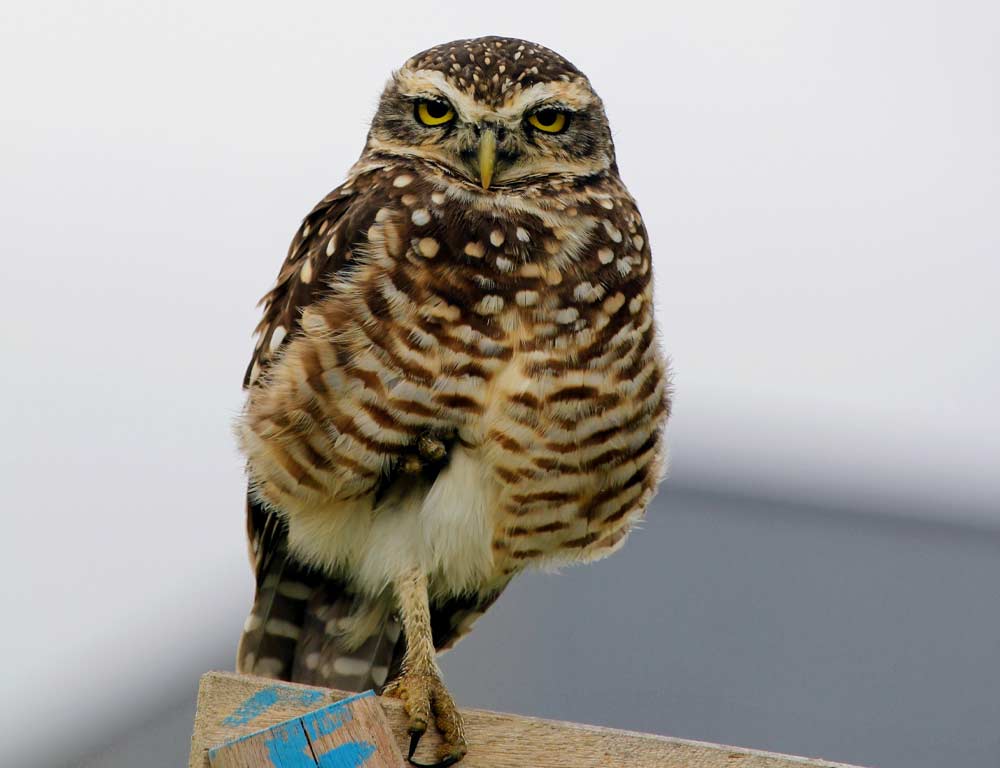
- Scientific Name: Athene cunicularia
- Size: 7-11 inches
- Weight: 5-8 ounces
- Food: Insects, small mammals, reptiles
- Wingspan: 21-24 inches
- Population: Declining in some areas
- Life Span: 6-8 years (wild)
- Status: Least Concern
The Burrowing Owl is unique among owls, favoring open habitats like grasslands and prairies.
It often nests in abandoned burrows dug by other animals, demonstrating its adaptability. Highly diurnal, it hunts during the day, preying on insects, small mammals, and reptiles.
Its distinctive behavior, including head bobbing and ground-dwelling lifestyle, sets it apart from other owl species. Conservation efforts are crucial, as some populations face threats from habitat loss and changes in land use.
7. Short-eared Owl
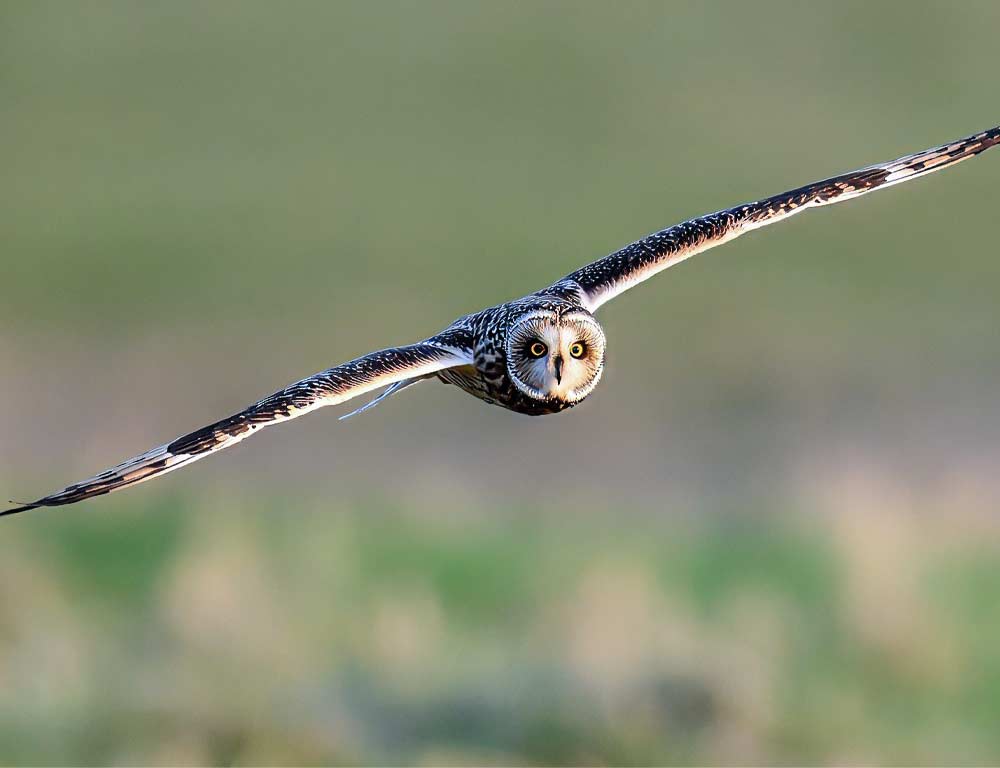
- Scientific Name: Asio flammeus
- Size: 13-17 inches
- Weight: 7-17 ounces
- Food: Small mammals, birds, insects
- Wingspan: 33-43 inches
- Population: Varied, with fluctuations
- Life Span: 3-4 years (wild)
- Status: Least Concern
The Short-eared Owl is a medium-sized owl that frequents open landscapes such as grasslands and marshes. Known for its distinctive facial disk and short “ear” tufts, it is crepuscular and hunts during dawn and dusk.
Preferring to roost on the ground, it relies on its keen hearing to locate prey like small mammals, birds, and insects. Short-eared Owls are known for their erratic flight patterns during courtship displays.
Their population can vary, with factors like prey availability influencing their abundance. Conservation efforts focused on preserving open habitats are vital for maintaining healthy Short-eared Owl populations in Colorado.
8. Long-eared Owl
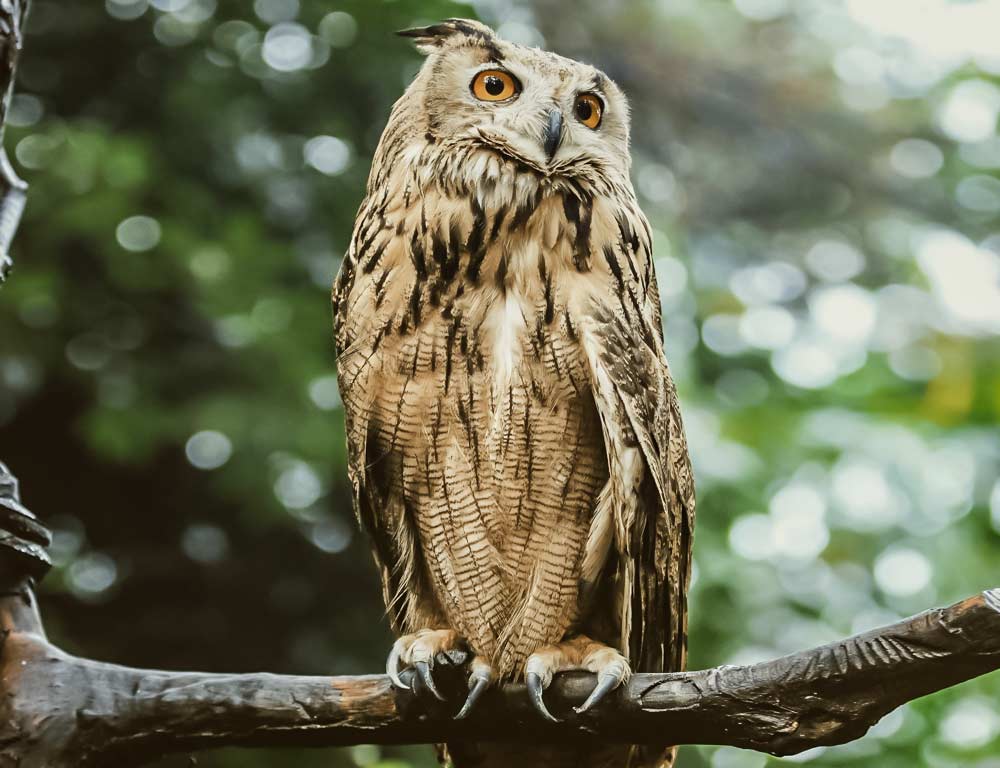
- Scientific Name: Asio otus
- Size: 13-16 inches
- Weight: 7-16 ounces
- Food: Small mammals, birds
- Wingspan: 35-39 inches
- Population: Widespread but secretive
- Life Span: 4-10 years (wild)
- Status: Least Concern
The Long-eared Owl, with its distinctive long “ear” tufts, is a medium-sized owl that occupies various habitats, including woodlands and coniferous forests in Colorado.
Despite being widespread, it is secretive and often difficult to spot due to its excellent camouflage.
Primarily nocturnal, it preys on small mammals and birds. Long-eared Owls are known for their roosting behavior, often choosing dense vegetation for concealment during the day.
Their populations can be affected by habitat loss and disturbance, emphasizing the importance of conservation measures to protect their preferred habitats.
9. Barred Owl
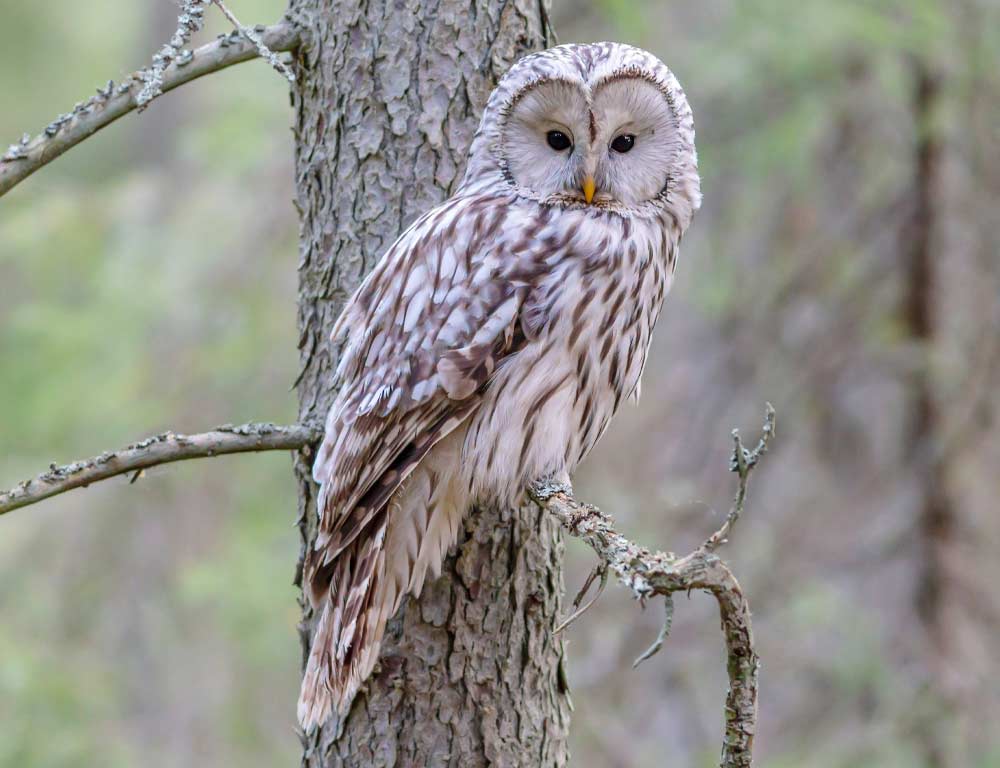
- Scientific Name: Strix varia
- Size: 16-24 inches
- Weight: 1-2.3 pounds
- Food: Small mammals, birds, amphibians
- Wingspan: 38-49 inches
- Population: Increasing in some areas
- Life Span: Up to 10 years (wild)
- Status: Least Concern
The Barred Owl is a large, distinctive owl with a hooting call that echoes through the woodlands of Colorado. It is known for its dark eyes and barred plumage and is adaptable to various habitats, including forests and swamps.
Primarily nocturnal, it preys on small mammals, birds, and amphibians. Barred Owls are cavity nesters, often taking over abandoned nests of other large birds.
Their populations have increased in some areas, possibly due to habitat changes and the decline of the Spotted Owl, with which they compete. Their adaptability to human-altered landscapes makes them common in certain parts of Colorado.
10. Flammulated Owl
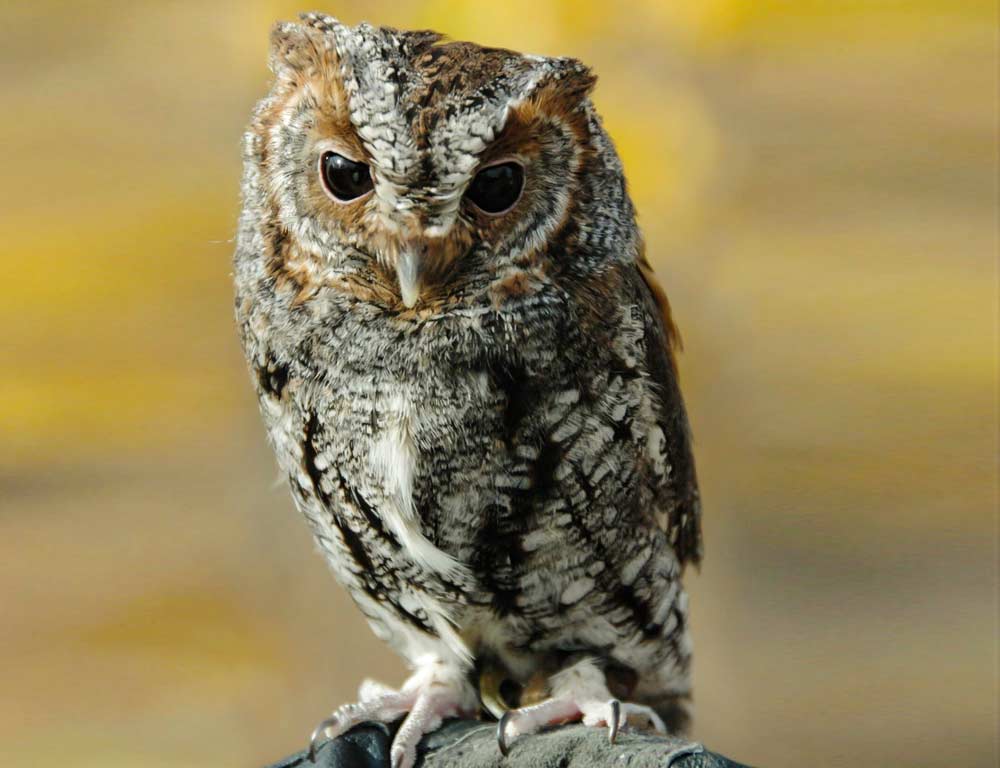
- Scientific Name: Psiloscops flammeolus
- Size: 6-7 inches
- Weight: 1.5-2 ounces
- Food: Insects
- Wingspan: 15-18 inches
- Population: Stable
- Life Span: 3-4 years (wild)
- Status: Least Concern
The Flammulated Owl, one of the smallest owls in North America, is a migratory species that breeds in Colorado’s montane forests.
It has a flame-patterned facial disk and primarily feeds on insects. Despite their small size, Flammulated Owls are crucial in controlling insect populations.
They nest in tree cavities and rely on mature, open forests for breeding. Conservation efforts that protect their breeding habitats are essential to maintaining stable populations of these small, insect-eating owls in Colorado.
11. Northern Saw-whet Owl
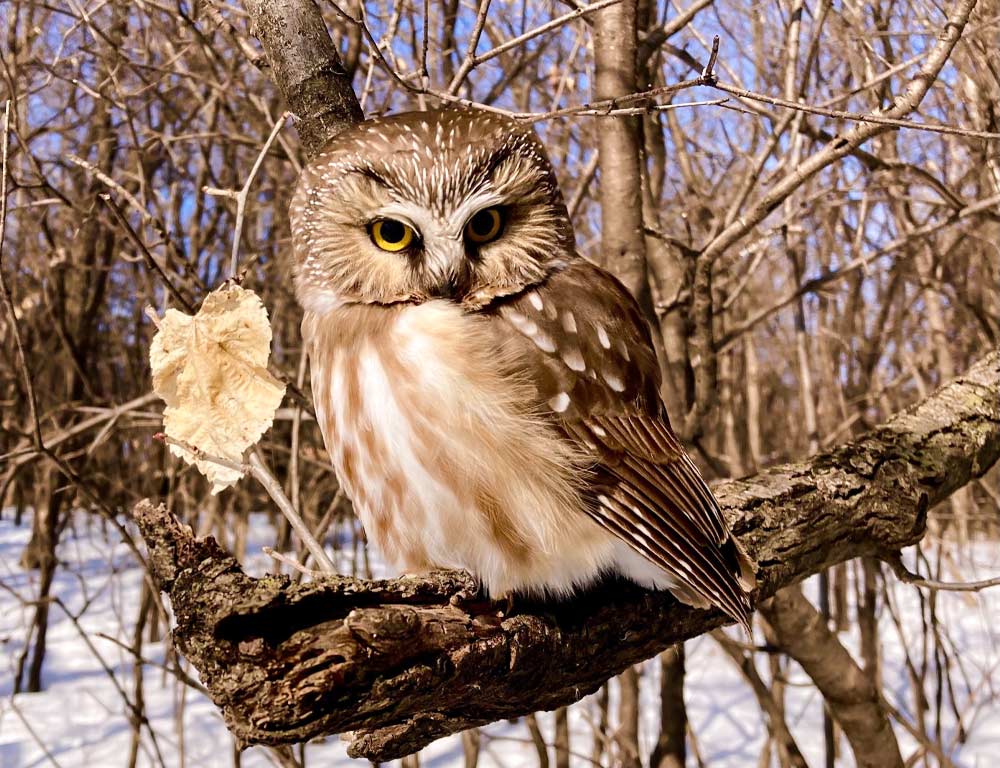
- Scientific Name: Aegolius acadicus
- Size: 7-8 inches
- Weight: 2-5 ounces
- Food: Small mammals, birds, insects
- Wingspan: 16-18 inches
- Population: Stable
- Life Span: 3-5 years (wild)
- Status: Least Concern
The Northern Saw-whet Owl, a small and secretive owl, is found in various forested habitats in Colorado. Its distinctive “tooting” call is often heard during the breeding season.
Primarily nocturnal, it preys on small mammals, birds, and insects. The saw-whet owl is cavity-nesting, utilizing natural tree hollows or old woodpecker nests. Despite being widespread, its secretive nature makes it challenging to study.
Conservation measures focusing on preserving mature forests and protecting nesting sites contribute to maintaining stable populations of Northern Saw-whet Owls in Colorado.
12. Boreal Owl
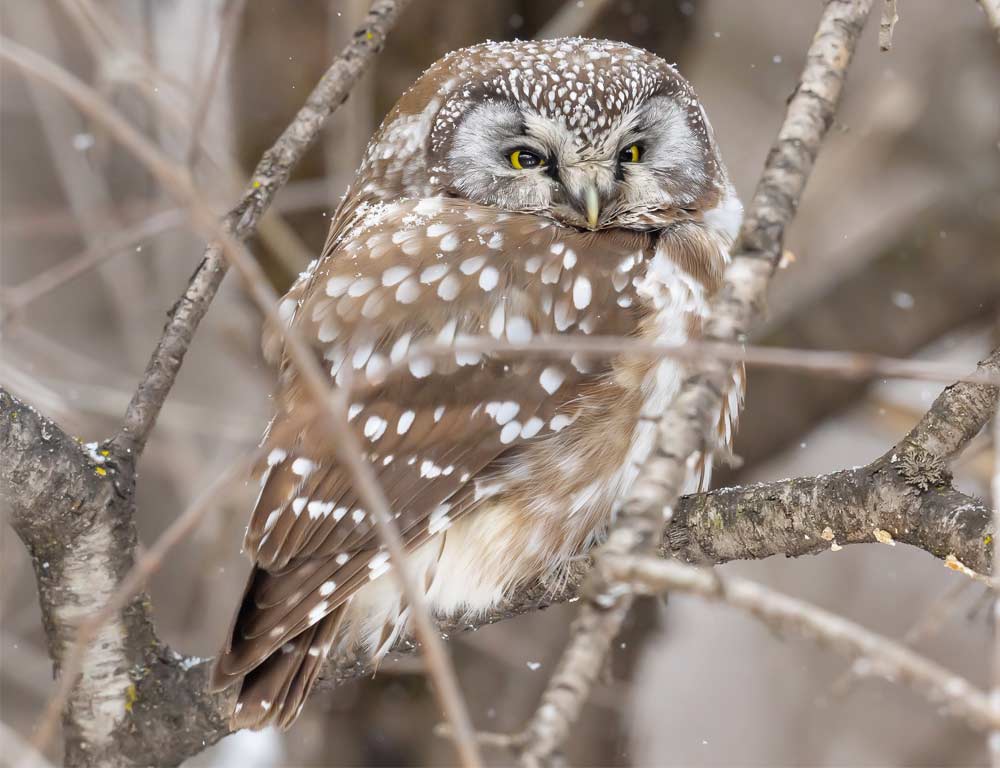
- Scientific Name: Aegolius funereus
- Size: 8-12 inches
- Weight: 3-7 ounces
- Food: Small mammals, birds, insects
- Wingspan: 21-24 inches
- Population: Widespread but not well-studied
- Life Span: 3-5 years (wild)
- Status: Least Concern
The Boreal Owl, a small owl with a round facial disk and dark eyes, inhabits dense coniferous forests in Colorado. Preferring higher elevations, it is often found in subalpine and boreal zones.
Primarily nocturnal, it preys on small mammals, birds, and insects. Boreal Owls are cavity nesters, utilizing old woodpecker holes or natural tree hollows for nesting.
Despite being widespread, their secretive nature and remote habitats make them challenging to study. Conservation efforts focused on maintaining healthy, diverse forests are crucial for the well-being of Boreal Owl populations in Colorado.
13. Northern Pygmy Owl
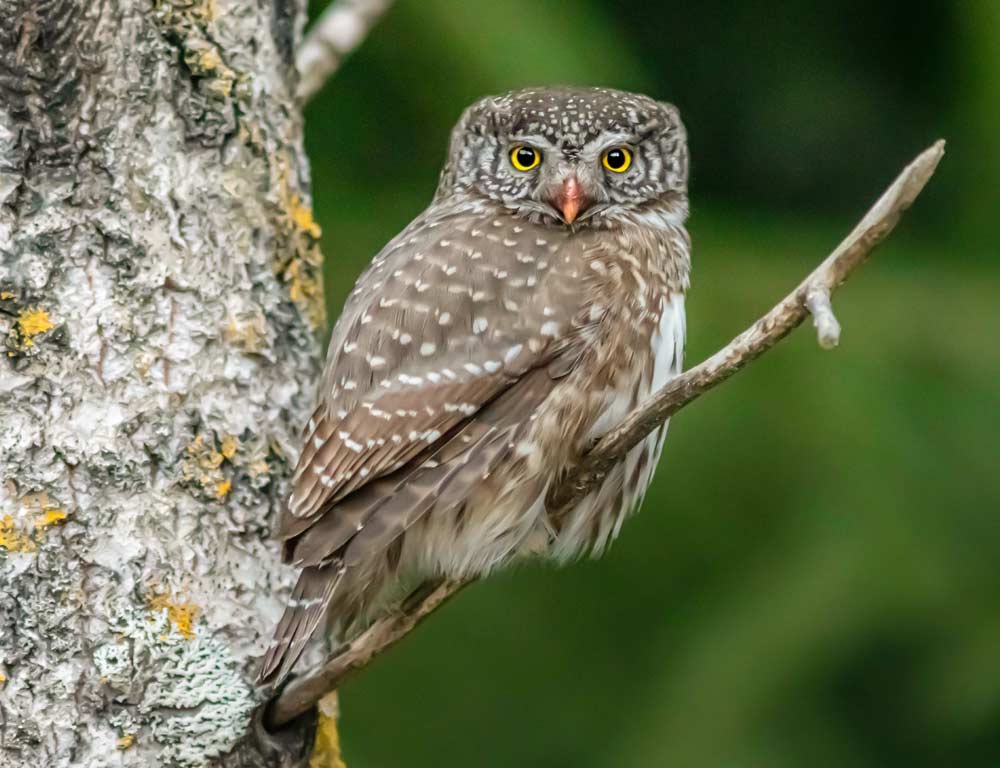
- Scientific Name: Glaucidium californicum
- Size: 6-7 inches
- Weight: 2-3 ounces
- Food: Small mammals, birds, insects
- Wingspan: 12-14 inches
- Population: Stable
- Life Span: 3-7 years (wild)
- Status: Least Concern
The Northern Pygmy Owl is a small, diurnal owl with a round head and prominent white eyebrows.
In Colorado, it occupies various wooded habitats, including coniferous and mixed forests. Despite its small size, it is a fierce predator, preying on small mammals, birds, and insects.
The pygmy owl is known for its agility and ability to hunt in dense vegetation. It may engage in courtship displays during the breeding season, including calling and bobbing.
Conservation efforts focusing on maintaining suitable habitats for nesting and hunting contribute to the stability of Northern Pygmy Owl populations in Colorado.
14. Spotted Owl
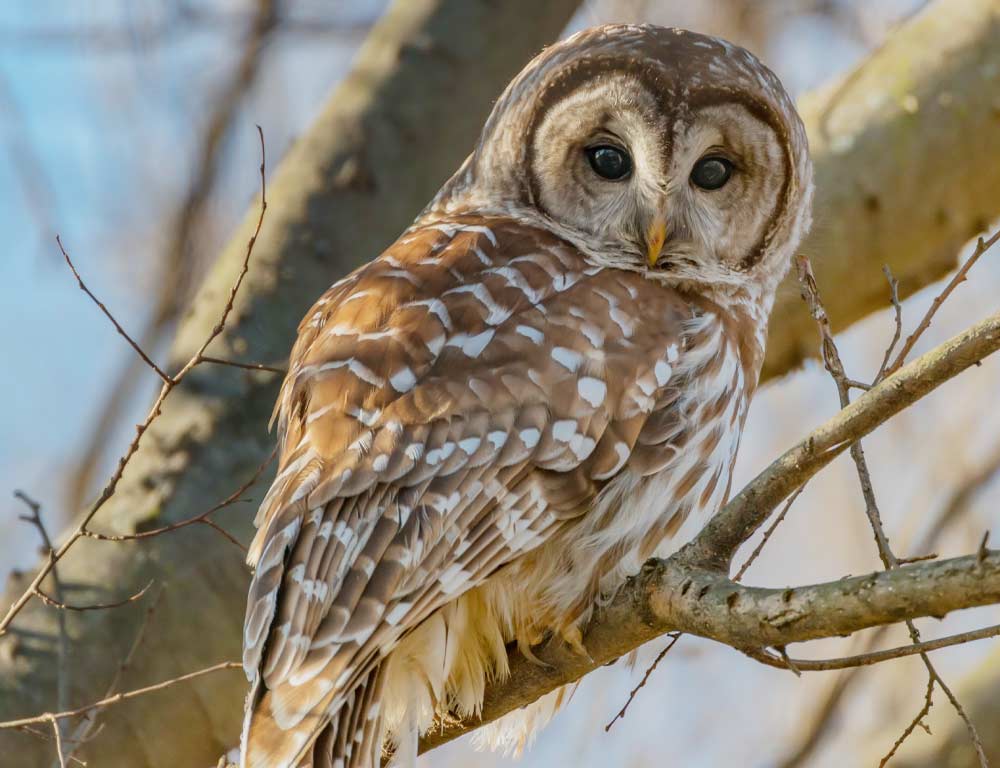
- Scientific Name: Strix occidentalis
- Size: 16-19 inches
- Weight: 1-2.5 pounds
- Food: Small mammals, birds
- Wingspan: 40-45 inches
- Population: Declining
- Life Span: Up to 18 years (wild)
- Status: Near Threatened
The Spotted Owl, known for its dark eyes and mottled plumage, primarily inhabits old-growth forests in Colorado. It relies on these mature forests for nesting and hunting.
The species faces significant conservation challenges due to habitat loss, logging activities, and competition with the Barred Owl.
Spotted Owls are known for their unique hooting calls during the breeding season. Conservation efforts, including habitat protection and management, are critical to the survival of Spotted Owls in Colorado.
Monitoring and addressing the ongoing threats are essential for mitigating the decline in their populations and maintaining the ecological balance of their forest habitats.
15. Mountain Pygmy Owl
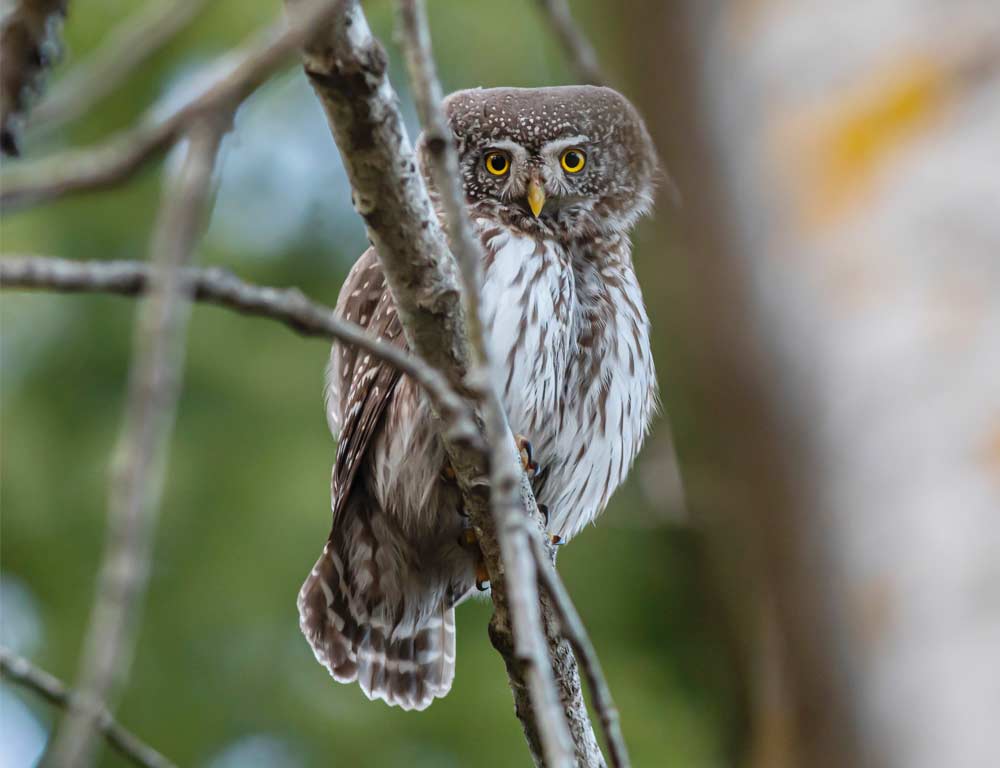
- Scientific Name: Glaucidium gnoma
- Size: 6-7 inches
- Weight: 2-3 ounces
- Food: Small mammals, birds, insects
- Wingspan: 12-14 inches
- Population: Stable
- Life Span: 3-7 years (wild)
- Status: Least Concern
The Mountain Pygmy Owl, a small and diurnal owl, is found in various forested habitats, including coniferous and mixed forests in mountainous regions of Colorado.
Its distinctive round head and prominent white eyebrows make it an agile predator, preying on small mammals, birds, and insects.
Despite its small size, the pygmy owl is known for its ferocity in hunting. It may engage in courtship displays during the breeding season, including vocalizations and aerial acrobatics.
Conservation efforts that focus on maintaining healthy forest ecosystems contribute to the stability of Mountain Pygmy Owl populations in Colorado.
16. Mexican Spotted Owl
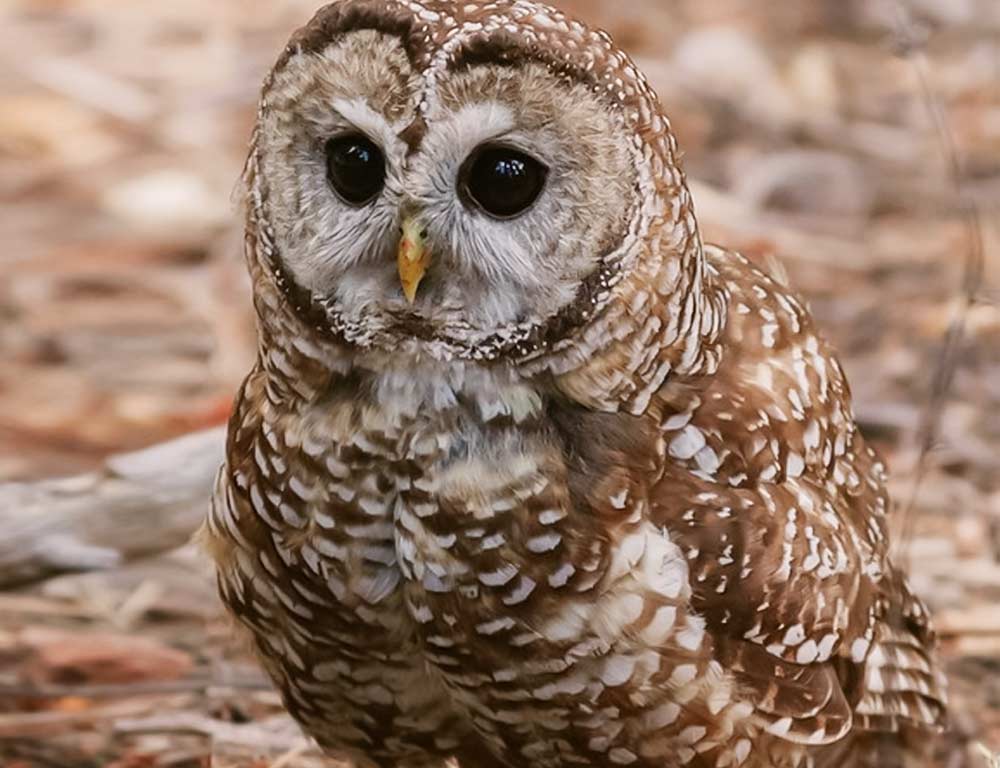
- Scientific Name: Strix occidentalis lucida
- Size: 17-19 inches
- Weight: 1.5-2.5 pounds
- Food: Small mammals, birds
- Wingspan: 42-45 inches
- Population: Declining
- Life Span: Up to 18 years (wild)
- Status: Near Threatened
The Mexican Spotted Owl, a subspecies of the Spotted Owl, is adapted to southwestern forests, including parts of Colorado.
Recognized by its mottled plumage and dark eyes, it prefers mature and old-growth forests for nesting and hunting.
Facing threats from habitat loss due to logging, urbanization, and wildfires, Mexican Spotted Owls are experiencing population declines.
Conservation efforts, including habitat preservation and management, are crucial for the survival of this subspecies in Colorado.
Monitoring and mitigating the impacts of human activities on their habitats are essential for ensuring the long-term viability of Mexican Spotted Owl populations in the region.
Wrapping Up
In the tapestry of Colorado’s landscapes, owls play a captivating role. From the majestic hunters of the night to the elusive daylight predators, these birds enrich the state’s biodiversity.
By understanding their sizes, habitats, and conservation needs, we appreciate the delicate balance these owls maintain.
As we traverse Colorado’s diverse terrains, let’s continue to celebrate and protect these enigmatic creatures, ensuring their presence in the state’s ecosystems for generations to come. Thank you so much.